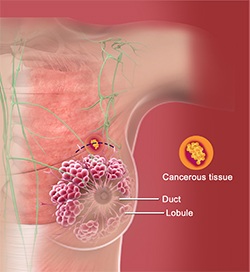Breast Cancer Surgery

Breast cancer surgery involves the surgical removal of a breast tumour and a portion of the surrounding normal tissue to prevent its spread to the other parts of the body. Breast cancer is malignant (spreads to other parts) and uncontrolled growth of breast cells. It is caused due to a genetic abnormality, which can be inherited, but mainly occurs due to aging and wear and tear of the body.
Breast cancer generally begins in lobules (milk-producing glands) or ducts (milk-draining passages extending from the lobules to the nipple). Breast cancer can sometimes occur in the fatty and fibrous breast tissues. If left untreated, the tumour cells may invade the nearby healthy breast tissues and into the lymph nodes of the underarm, which can spread to other body parts.
Diagnosis
Self-breast examinations, mammograms, biopsies, blood tests and imaging studies can be ordered by your doctor to detect and monitor breast cancer.
Surgical procedures
Breast cancer is generally treated with a combination of surgery, hormone therapy (blocks some hormones), radiation therapy (use of high-energy rays) and chemotherapy (use of certain drugs). Deciding on the appropriate type of surgery for you will depend on the stage of cancer, type of cancer and its long-term benefits.
The two main types of breast cancer surgeries include:
- Partial mastectomy or breast-conserving surgery: This involves the removal of only the tumour along with a small margin of the surrounding breast tissue.
- Mastectomy: involves removal of the complete breast tissue.
The various types of mastectomy procedures include:
- Simple or Total Mastectomy: A/Prof Fosh will remove the entire breast and sometimes the lymph nodes from the armpit by making a 6 to 7-inch long elliptical cut starting from the inside of the breast, close to the breast bone, and continuing up and out toward the armpit.
- Skin-Sparing Mastectomy: A/Prof Fosh will remove the breast tissue. Most of the breast skin is preserved with this technique, which is generally lost in traditional mastectomy. It provides the best option if immediate breast reconstruction is suitable.
- Nipple-Sparing Mastectomy: A/Prof Fosh will make an incision in the fold of skin under or to the side the breast, where the cut cannot be easily seen after healing, and will spare the nipple.
- Preventive/prophylactic or risk-reduction mastectomy: If you are genetically predisposed and have a high risk of developing breast cancer, you may choose to have risk reducing surgery. A simple mastectomy, skin-sparing or nipple-sparing mastectomy can be performed.
- Therapeutic Mammaplasty: In some cases where the patient has a breast cancer in a larger breast, A/Prof Fosh can sometimes use a breast reduction technique to remove the tumour safely.
- Lymph node dissection: Either a sentinel node biopsy, or an axillary dissection is often needed to be performed to stage the breast cancer to assess what type of treatment is needed. The removal of the lymph nodes is an important step in breast cancer surgery as the cancer cells can spread to the other parts of the body through the lymph.
Post-operative care
Breast surgery sometimes involves an overnight stay in hospital
You will be prescribed medicines to relieve pain. You may be discharged with an external drainage device to collect fluid from the surgical site. You should keep the incisions clean and dry for a week after the surgery, but will be able to have a shower. You may experience tingling, numbness or discomfort in the armpit. Any bruising or swelling should lessen after a few days. You will be instructed to begin arm exercises on the next day after surgery to prevent stiffness.
You will be able to continue with your normal activities within a few days to weeks after breast surgery
Risks and complications
As with any surgery, breast cancer surgery involves potential risks and complications. They may include:
- Hematoma (accumulation of blood in wound) and seroma (accumulation of fluid in wound)
- Excessive bleeding
- Lymphoedema (accumulation of lymph fluid in the arm)
- Wound infection
- Nerve pain
- Scar formation in the armpit
